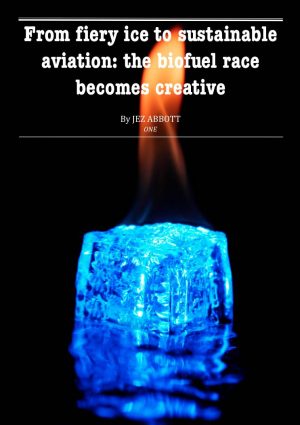 The search for alternative fuels struck lucky off the coast of Japan recently. Under the water and below the seabed are pockets of methane, trapped in ice. Put a match to this ice back on dry land and it not only melts, it ignites. Could this be the next big break in alternative fuel technology?
The search for alternative fuels struck lucky off the coast of Japan recently. Under the water and below the seabed are pockets of methane, trapped in ice. Put a match to this ice back on dry land and it not only melts, it ignites. Could this be the next big break in alternative fuel technology?
Very possibly reckon several large international research programmes and multinational firms that have set sail to the seas around Japan to explore these icy blocks. If tests on this substance – called fiery ice – go well, commercial mining could start in about 12 years. Estimates suggest methane hydrates make up a third of the total carbon held in other fossil fuels such as oil, gas and coal.
And several nations, not just Japan, want to tap into the potential. The problem however is bringing the gas to the surface, scientist Carolyn Ruppel told the BBC. Ruppel, who heads up the gas hydrates project for the US Geological Survey, explains methane hydrates are too sensitive to pressure and temperature changes to conventionally mine and pipe to land.
Typically they form several hundred metres beneath the seafloor where pressures are much higher and temperatures at freezing point. Removing them from these frigid atmospheres could make them break down before the methane can be harnessed. But there are ways to do it and a Japanese government-funded research programme is looking at those ways.
Japan Oil, Gas and Metals National Corporation is one of the leading research organisations in the country’s national gas hydrates programme, and to date has experienced patchy success. Another trailblazer is Hawaii Natural Energy Institute, but technical translator Ai Oyama explains the biggest stumbling block is neither technical nor financial, but emotional.
While some people welcome the search for fiery ice and the possibility of Japan becoming energy independent and environmentally cleaner, others fear any technique that prods or disturbs seafloor areas near tectonic plate boundaries. “In general,” he says, “people just feel really scared to do anything to the ocean floor. The place is known to be unstable and where earthquakes happen.”
Not just earthquakes. Extraction involves releasing a lot of methane gas suddenly into the ocean, which could potentially add vast amounts of the greenhouse gas to the atmosphere. Methane hydrate also releases water when it destabilises, which could stir sediment and fracture seabeds leading to landslips or even, some environmentalists reckon, a tsunami.
From below the sea, to above the clouds, the search for alternative fuels runs high and low. The aviation industry took a landmark step in autumn 2018 towards making commercially viable sustainable aviation fuel a reality. It is made using recycled waste industrial gases. The Boeing 747 flight – a world first – was led by Virgin Atlantic and LanzaTech and took off from Orlando.
Virgin Atlantic founder Sir Richard Branson marshalled the aircraft on its landing at London Gatwick. It followed a £410,000 (€462,000) UK government grant to test the feasibility of building a 50-million US gallon jet fuel plant in Britain. Up to 125 million gallons a year would fuel every Virgin Atlantic flight from Britain, and provide nearly one million tonnes of CO2 savings.
LanzaTech produces next-generation ‘advanced’ fuels by recycling carbon-rich waste industrial gases like those produced from steel making. Ethanol from the waste gases is made into the jet fuel and other low-carbon products. Using a plentiful, affordable waste stream has a strong sustainability profile and also allows a comparable price point to current fossil jet fuel. LanzaTech has made advances in scaling up its technology and is now tantalisingly close to its first commercial plant.
Virgin Atlantic is calling on the UK government to promote carbon-capture and utilisation technologies through the kind of incentives given to earlier generations of biofuels. The EU meanwhile is well entrenched in its promotion of alternative fuels through policy and incentives. The so-called Clean Mobility Package includes an action plan for the deployment of alternative fuels infrastructure that centres on €800 million of grants to leverage loans and additional public and private investment.
Such policy drives may strike a chord with the S&D Group, a centre-left political group of socialists and democrats in the European Parliament with members from all 28 EU countries. Spokesman Ismail Ertug says 94% of Europe’s transport sector depends on oil. Transport meanwhile is the only major economic sector in the EU where greenhouse gas emissions have increased since 1990.
In September 2018, the parliamentary committee on transport backed a proposal by MEP Ertug to introduce binding national targets on the deployment of alternative fuels infrastructure. Ertug who is calling for tough infrastructure targets and “sufficient” public funding, says out of roughly 800,000 charging points envisaged by 2025, just over 100,000 were currently in place.
Transport may well be the only major economic sector where greenhouse gas emissions are going up, but sections claim to be cleaning up their act. Oil giant ExxonMobil has been exploring how to turn algae into low-emission transport fuel for almost a decade. Working with Synthetic Genomics Inc, it is looking at how to scale up algae biofuels for potential commercial deployment for trucks, planes and other large transportation vessels.
In 2018, the two companies started the latest phase of their research project by farming wild algae in outdoor ponds and by 2025 they hope to have reached the technical ability to produce 10,000 barrels of algae biofuel per day. This will signal a key “engineering milestone” for large-scale production of algae biofuel, insists ExxonMobil.
Another oil titan, BP, is part of a joint venture with Du Pont called Butamax, which has developed technology to convert sugars from corn into an energy-rich biofuel known as bio-isobutanol. Not only can it be blended with gasoline at higher concentrations than ethanol, but it can also be transported through existing fuel pipelines and infrastructure.
BP also creates biopower to heat and light buildings from burning bagasse, the fibre that remains after crushing sugarcane stalks. In 2017 the company’s three biofuel-manufacturing facilities produced around 850 gigawatt hours of low-carbon electricity – enough renewable energy to power all of those sites and export the remaining 70% to the local electricity grid.
Furthermore, the CO2 emitted from burning bagasse is offset by the CO2 absorbed by sugarcane during its growth.
When the Virgin Atlantic plane touched down in London, the UK’s energy and clean growth minister Claire Perry hailed the kind of scientific endeavour that leads to alternative fuels for jets and homes. She also praised the exploratory drive that leads pioneers to areas such as the seas around Japan.
“Applying innovative solutions to real-world climate change challenges will help us transition to a greener, cleaner economy,” she said. “We are backing this kind of outside-the-box thinking to ensure we modernise our industries and accelerate the shift to low-carbon living.”
Jez Abbott





